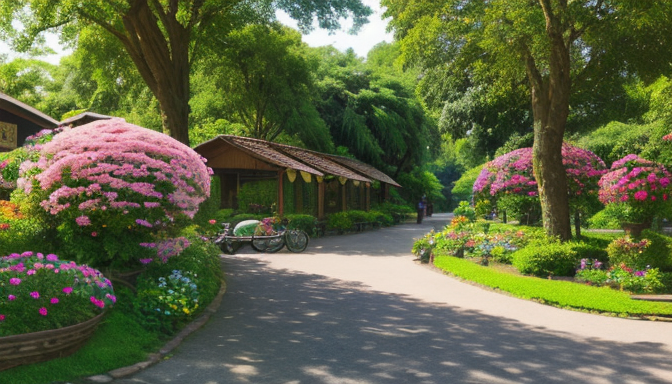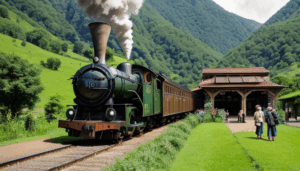In today’s fast-paced world, where everything is just a click away, the concept of slow travel is gaining momentum. But what exactly does it mean to travel slowly? Imagine savoring every moment of your journey, rather than racing from one tourist hotspot to another. Slow travel is all about immersing yourself in a destination, truly experiencing its culture, and connecting with the people who call it home. It’s like taking a deep breath of fresh air after being in a crowded room; it refreshes your spirit and opens your mind.
This rising trend encourages travelers to prioritize quality over quantity. Instead of ticking off a checklist of places to see, slow travelers focus on a few key experiences that resonate with them. Whether it’s sharing a meal with locals, wandering through quaint streets, or simply enjoying a sunset, these moments create lasting memories that are far more fulfilling than a hurried itinerary. Think of it as savoring a delicious meal instead of gulping it down; the flavors linger longer, and the experience is far richer.
Moreover, slow travel aligns perfectly with the growing awareness of sustainability. By spending more time in one place, travelers can reduce their carbon footprint and contribute positively to local economies. It’s a win-win! You get to enjoy an authentic experience while also being a responsible traveler. As we embrace this new way to explore, we not only enrich our own lives but also foster a deeper connection with the world around us.
The Philosophy of Slow Travel
Slow travel is not just a trend; it’s a mindset that encourages us to take a step back and truly immerse ourselves in the world around us. Imagine wandering through a cobblestone street, the sun casting a warm glow as you sip on a locally brewed coffee. This philosophy emphasizes a meaningful connection with places, urging travelers to savor each moment rather than racing from one destination to another. It’s about the journey, not just the destination.
At its core, slow travel is about mindfulness. It invites us to engage with local cultures on a deeper level, fostering genuine interactions that often get lost in the hustle of traditional travel. Instead of checking off a list of tourist attractions, slow travelers take the time to explore hidden gems, engage in conversations with locals, and participate in community events. This approach not only enriches the travel experience but also cultivates a sense of belonging and understanding.
Consider the principles of slow travel:
- Quality over Quantity: Focusing on fewer destinations allows for deeper exploration.
- Mindful Engagement: Taking the time to observe and appreciate the nuances of different cultures.
- Environmental Awareness: Traveling at a slower pace often leads to more sustainable practices.
By adopting this philosophy, we open ourselves to a world of rich experiences and personal growth. Slow travel teaches us that sometimes, the best memories are made not in the places we visit, but in the moments we share and the stories we create along the way. So, the next time you plan a trip, ask yourself: are you ready to slow down and truly savor the adventure?

Benefits of Slow Travel
When it comes to travel, we often find ourselves caught in the whirlwind of itineraries, ticking off landmarks like items on a grocery list. But what if I told you that the real magic happens when you take a step back and embrace the art of slow travel? This approach is all about immersing yourself in the culture, savoring the local flavors, and building genuine connections with the people you meet along the way.
One of the most significant benefits of slow travel is the reduction of stress. Instead of racing from one tourist spot to another, you can take your time to enjoy the simple pleasures of life. Picture yourself sipping coffee at a quaint café, watching the world go by, rather than rushing to snap a photo of a famous monument. This slower pace allows you to breathe, relax, and truly absorb your surroundings.
Moreover, slow travel enhances cultural immersion. By spending more time in one place, you can engage with locals, learn their stories, and perhaps even pick up a few words of their language. Imagine sharing a meal with a family in their home, experiencing their traditions firsthand. This deep connection transforms your travel experience from a fleeting visit into a meaningful journey.
Another crucial aspect of slow travel is its environmental sustainability. By choosing to travel less frequently but more intentionally, you reduce your carbon footprint. Instead of hopping on multiple flights or driving long distances, you can explore nearby destinations or take public transport, which is often more eco-friendly. It’s a win-win situation—you get to explore at a leisurely pace while also being kind to our planet.
In essence, embracing slow travel not only enriches your experiences but also fosters a deeper appreciation for the world around you. So, why not take a moment to reflect on your next adventure and consider how you can incorporate the principles of slow travel into your plans? You might just discover that the journey is as beautiful as the destination.
How to Embrace Slow Travel
Embracing slow travel is all about shifting your mindset from a hurried tourist to a curious explorer. Imagine this: instead of racing from one attraction to another, you take the time to breathe in the atmosphere of a quaint village or enjoy a leisurely meal at a local eatery. It’s not just about the destination; it’s about the journey and the stories you collect along the way.
To truly dive into the slow travel experience, start by choosing your destinations wisely. Look for places that invite you to linger, where the pace of life is unhurried. Maybe it’s a small coastal town or a serene countryside. These spots often have rich histories and vibrant cultures that deserve your attention. When you arrive, allow yourself to get lost—literally and figuratively. Stroll through narrow streets, chat with locals, and soak up the surroundings.
Next, consider your itinerary. Instead of cramming in numerous activities, focus on a few key experiences each day. This might mean spending an afternoon at a local market or taking a cooking class to learn about the region’s cuisine. By engaging in these activities, you’ll not only learn more about the culture but also forge meaningful connections with the people you meet.
Additionally, transportation choices can enhance your slow travel experience. Opt for walking, biking, or even public transport instead of renting a car. This way, you’ll have the chance to observe daily life and discover hidden gems that you might miss while zooming by in a vehicle. Remember, the journey is just as important as the destination!
Finally, be open to spontaneity. The beauty of slow travel lies in its flexibility. If you stumble upon a local festival or a charming café, don’t hesitate to change your plans. Embrace the unexpected, and you might just find the most memorable moments of your trip.

Destinations That Encourage Slow Travel
When it comes to slow travel, some destinations shine brighter than others, inviting you to take a step back and truly immerse yourself in their unique beauty. Imagine wandering through charming cobblestone streets, savoring a freshly brewed cup of coffee while watching the world go by. These places not only beckon you to explore but also encourage you to embrace a more leisurely pace.
One such destination is Tuscany, Italy. With its rolling hills, vineyards, and quaint villages, Tuscany is the epitome of slow travel. You can spend days meandering through the countryside, stopping at local wineries for tastings, or enjoying a traditional meal at a family-owned trattoria. The essence of Tuscany lies in its ability to make you feel at home, urging you to savor every moment.
Another gem is Kyoto, Japan. Known for its stunning temples and serene gardens, Kyoto invites you to slow down and appreciate the art of mindfulness. Picture yourself wandering through the peaceful Arashiyama Bamboo Grove, where the gentle rustle of leaves creates a calming atmosphere. Here, you can participate in a traditional tea ceremony, connecting with the local culture in a way that fast-paced tourism simply cannot provide.
For those seeking coastal charm, Lisbon, Portugal offers a vibrant yet relaxed vibe. With its colorful streets and friendly locals, Lisbon encourages you to explore at your leisure. You can hop on a tram, visit local markets, and enjoy sunset views from the many miradouros (viewpoints) scattered throughout the city. The slower pace allows you to absorb the rich history and culture that Lisbon has to offer.
In conclusion, these destinations exemplify the beauty of slow travel. By choosing to explore places like Tuscany, Kyoto, and Lisbon, you’re not just visiting; you’re creating memories that will last a lifetime. So, why rush? Embrace the journey, and let these incredible locations guide you toward a more meaningful travel experience.
Challenges of Slow Travel
While the allure of slow travel is undeniable, it doesn’t come without its own set of challenges. One of the most significant hurdles is the time constraint. In our fast-paced world, many people have limited vacation days, making it tough to embrace the leisurely pace that slow travel demands. Imagine wanting to soak in the essence of a quaint village but only having a weekend to rush through it. This can lead to frustration, as travelers may feel pressured to fit everything into a short timeframe.
Additionally, slow travel requires a certain level of flexibility. Plans can change unexpectedly, whether due to weather, local events, or simply discovering something more interesting than what was initially on the itinerary. This adaptability is essential, but not everyone is comfortable with spontaneity. For some, the idea of altering plans on a whim can be daunting, as it strays from the structured travel experience they might be used to.
Another challenge is the financial aspect. While slow travel often promotes staying in one place longer and can lead to cost savings, the upfront costs of accommodations or extended stays can be higher in some locations. For instance, renting an apartment for a week might be more expensive than booking a quick hotel stay. However, when you factor in the potential for cooking your meals and the overall experience, it can balance out.
To navigate these challenges, it’s crucial to approach slow travel with an open mind and a willingness to adapt. Embrace the journey rather than just the destination, and remember that the best experiences often come from the unexpected. After all, isn’t that what travel is all about?
Frequently Asked Questions
- What is slow travel?
Slow travel is all about taking your time to explore a destination deeply. Instead of rushing from one tourist spot to another, it encourages you to savor each moment and connect with local cultures.
- What are the benefits of slow travel?
There are many perks! You get to experience less stress, enjoy richer cultural interactions, and contribute to sustainability. Plus, you create unforgettable memories by focusing on quality experiences over quantity!
- How can I start slow traveling?
Start by planning trips that allow for relaxation and exploration. Choose fewer destinations and spend more time in each place, engaging with locals and immersing yourself in the culture.
- Are there specific destinations ideal for slow travel?
Absolutely! Places known for their relaxed pace, like quaint villages or rural areas, are perfect for slow travel. Think of destinations that offer rich culture and community engagement.
- What challenges might I face with slow travel?
While slow travel is rewarding, it can come with challenges like time constraints and the need for flexibility. But don’t worry! Embrace these hurdles as part of the adventure and enjoy the journey.

